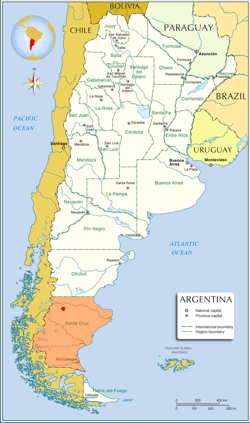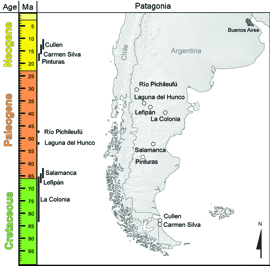 The Pinturas Formation outcrops in the Río Pinturas region southeast of the town of Perito Moreno. The formation as currently understood is divided into three sequences (lower, middle, upper) separated by unconformities; much of the formation is comprised of tuffs and eolian sandstones. The lower sequence may represent a forested habitat, whereas the middle and upper sequences may have had patchier forest and experienced intervals of dryness . Radiometric dates have been calculated based on samples from several localities (Cerro do los Monos, Portezuelo Sumich Norte, Estancia El Carmen) in the Pinturas Formation, yielding ages from about 16.43 Ma to 19.89 Ma, although the latter date may be too ancient. Some additional early attempts at dating are probably incorrect.
The Pinturas Formation outcrops in the Río Pinturas region southeast of the town of Perito Moreno. The formation as currently understood is divided into three sequences (lower, middle, upper) separated by unconformities; much of the formation is comprised of tuffs and eolian sandstones. The lower sequence may represent a forested habitat, whereas the middle and upper sequences may have had patchier forest and experienced intervals of dryness . Radiometric dates have been calculated based on samples from several localities (Cerro do los Monos, Portezuelo Sumich Norte, Estancia El Carmen) in the Pinturas Formation, yielding ages from about 16.43 Ma to 19.89 Ma, although the latter date may be too ancient. Some additional early attempts at dating are probably incorrect.
The formation is paleontologically rich. Trace fossils occur throughout the formation, including termite nests, dung beetle brood balls, cicada burrows, bee cells, and rodent burrows. A significant fossil mammal fauna has also been described, including marsupials, rodents, ground sloths, litopterns, and monkeys. Birds are known, although less thoroughly documented. Notably, the macroflora has not been documented, except for reports of tree trunks, as well as plant fossils (type not specified) in the lower sequence of the formation at the Cerro de los Monos and Loma de la Lluvia localities. The microflora has been briefly described in one abstract on pollen taxa (Zamaloa 1993) and in a paper on the freshwater green alga Pediastrum.
The Pinturas Formation plant macrofossils were discovered at the Cerro de los Monos locality, a fossil vertebrate locality that has yielded marsupials, rodents, ground sloths, litopterns, and monkeys. Sponge spicules, diatoms, spores, and pollen occur in the Pinturas Formation. In an abstract, Zamaloa (1993) reported that palynomorphs from Cerro de los Monos indicate a moderate, moist climate with forest vegetation, including bryophytes, pteridophytes, gymnosperms, and various angiosperm groups, such as Nothofagaceae, Proteaceae, Myrtaceae, and Winteraceae; the presence of freshwater algae and Sparganiaceae (semi-aquatic monocots) was interpreted as indicating a lacustrine environment.
Gandolfo Lab Research
Study of the flora of Pinturas is a collaborative effort between researchers at several institutions, including the Gandolfo lab at Cornell University (Ithaca, New York) and the Museo Paleontológico Egidio Feruglio (Trelew, Chubut Province, Argentina). The primary goal of this project is to document the diversity of the flora.
Lab Work
Much of the detailed work involved in describing and understanding species of fossil plants takes place in the lab. We employ many traditional methods of paleobotanical study, such as making observations, describing fossil species, and comparing fossil species to living plants, in order to understand the plants that we find in the field. In addition, we use modern analytical techniques to attempt to gain a more precise understanding of the evolutionary relationships of fossil and living plants.
Other Paleofloras
(Youngest-Oldest)
- Cenozoic Paleofloras
- Cullen (middle Miocene)
- Carmen Silva (Miocene)
- Pinturas (late-early Miocene)
- Río Pichileufú (early-middle Eocene)
- Laguna del Hunco (Early Eocene)
- Salamanca (early Paleocene)
- Cretaceous Paleofloras
- Lefipán (Maastrichtian- 65.5-66 myo)
- La Colonia (Campanian to Maastrichtian)
Pinturas Information
Copyright © 2020 · All Rights Reserved
